Mind Streaming
John Coxon's Online Journal|
Archive Search |
| Links |
|
and s-integrator |
Thursday, June 12, 2003
A Typical Anglican Parish Church
Sunday, June 08, 2003
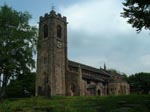
The church, with its extensive graveyards,of St. Mary's parish church in Prestwich, near Manchester, has been a local landmark for centuries.With its extensive, partly wooded graveyard, on the south and west facing slopes of its grounds , it is one of my favourite tranquil places to visit and walk around. It is so full of interest. St Mary's is very typical of so many of the prolific local English parish churches that populate the English countryside providing a visible sense of stability and continuity of community, even though for many, congregations have diminished.
There was, according to local records, a place of worship on this site as far back as 1145 A.D.
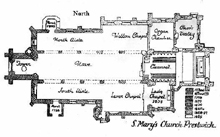
The current building is hard to date precisely as it is an historical composite of various additions to it made over a number of centuries. This plan of the church shows details of the layout and the various ages of different sections of the building, starting from the 15th century.
As you come into the grounds through the iron gates opposite the Church Inn pub,
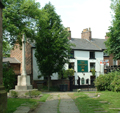
to your right is an outhouse that was originally the town mortuary in the 18th century.

To your left is a set of stone steps, used, originally by members of the congregation who rode horses to church, to mount and dismount. The church itself is predominantly constructed in a rose-red coloured sandstone; there is some very old graffiti, very well carved, on the west walls, some dating from the time of Nelson.
The oldest gravestone in the church ground dates from 1641 and is the last resting place of the children of one Thomas Collier whose children were buried "bewtixt the 1st and the of 12th of December" in that year.
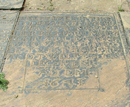
It seems likely that Thomas Collier may have carved their headstone himself. You can see the lettering style changes that indicate someone not used to carving in stone and it adds to the poignancy of what was a family catastrophe.
Like many parish churches, St Mary's is built on a hill, emphasing the importance and indeed power of the Church , especially in former times, and of course, enabling the church tower bells to be heard from miles around.
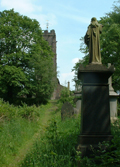
Whilst the majority of the headstones seem to be from the Victorian and Edwardian era, there are many more recent. On the small grassed areas on the eastern and south western sides of the building are a number of small, horizontally laid stones under which are interred the ashes from more recent cremations. I have chosen this example because I know the mason who carved the lettering.

Thisbeautiful gothic script is the work of local stone mason, Arthur Atherton, whose workshop I once had the privilege to visit. (He generously gave me one of the stone carving chisels he used as a souvenir , something I cherish.) Arthur's style is very distinctive. I can easily identify the numerous examples of his work all over the graveyards. He learned this style, during his apprenticeship, from a Victorian mason. Whilst most monumental masons these days charge higher fees for elaborate scripts, Arthur does not because that is his personal style ; the one he's always used and continues to use.
Within the graveyard are a number of soldiers graves, easily spotted because the majority have been fashioned from white Portland stone (a white limestone which does not stand up too well to the atmosphere and climate in these parts and many are weathered quite badly.) The shape of military head stones is uniform. The tradition here is to carve a cross, the serviceman or womans' rank, serial number, the name of the regiment and the regimental badge and the precise date of death.
Many of the old local regiments represented here now no longer officially exist as they have been merged into larger regiments. One of the soldiers is a Canadian Infantryman, Private G.H.Longstaff, ( died 29th April , 1917.) There is one female military grave, that of Beatrice Slack (died 2nd June 1946) who was in the ATS ( Auxillary Territorial Service -as was my mother incidentally)
There are just two graves of RAF servicemen amongst the military people buried here. Seargeant W.S.Wadsworth ( died 5th april , 1942) .
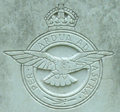
There is also the headstone of RAF Sergeant J.T. Anderton (died 11th June , 1943) but the excellent condition of the stone suggests that it is a recent reburial, since the gravestone of RAF Sergeant Wadsworth has damage from weather erosion which suggests that stone has been there since 1943. One possibility is that, for example in Holland, aviation archaeologists and historians have been tirelessly excavating the wreckage of Second World War aircraft and going to great lengths to identify and then repatriate our WW2 aircrew. You notice that Sergeant Anderton was a wireless operator/gunner, and there were terrible casualty figures amongst crew who fulfilled that dangerous roll in Bomber Command over Europe.
Recently, it appears, someone has been working hard throughout the church grounds clearing the weeds and brambles from around all the military graves, whilst, the majority of often impressive, predominantly grey, Victorian and Edwardian stones remain partly obscured by high weeds and brambles.
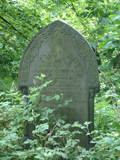
There is a poignant site in the north west side of the churchyard where, as if lined up for the final parade, are the stones of twelve men who died during the First World War. These stones are made of a tougher, darker stone and have weathered well in comparison to those fabricated from Portland Stone.

I always go over to these graves when I visit this grave yard and one of the stones saddens me because it simply marks that the remains of Private T. Anderson of the Manchester Regiment were "buried in this churchyard" but where ?
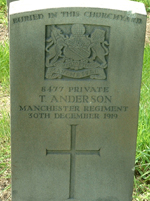
Anotherthing you notice in the graveyard is that many of the graves (of probably more eminent local residents) clearly had cast iron railings around them or cages over them, possibly to prevent the theft of bodies at a time when illicit premiums were paid by those , in the early days of medicine and surgery , wanting bodies to study human anatomy.
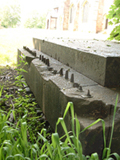
There is , however only the stub remnants of these metal railings because, very probably, the metal was taken away to be melted down during the WW 1.
During my days teaching very disturbed children, I used to bring them, with gardening tools, to the churchyard and we would spend happy hours clearing brambles and weeds from headstones. The church has many beautiful, original stained glass windows, and inevitably then, before protective grills and outer tough glass were put on to protect them, some idle fools from nearby would damage them with stone throwing. We used to scratch around under the windows for fragments of the old glass left by the glaziers.
( I remember one time, we were in the church grounds when we met , somewhat incongruously, an American couple. The lady had been married in this very church before she emigrated to America. She had been very emotional and moved at coming back to visit St Mary's with all the memories it held for her. I struck up a friendly conversation with her and explained why we were there. Realising how important the place was to her, I went down on my knees and scratched around in the grass by the church wall and found what I wanted and knew she would appreciate ; a small fragment of original glass from one of the stained glass windows that had been repaired. She wept when I gave it to her and talked excitedly about having it mounted as a pendant by a jeweller when she got back to the states. I felt very happy about that.)
Part of the lower graveyard on the south facing slope is wooded. Just the other day, on my last visit, I spotted a rare sight ; a beautiful Jay, hopping from tree to tree as I tried to line up for a photograph. The bird clearly was not keen to have his portrait taken an and led me a merry dance ; in the end I had to give up the idea.

Thereare numerous huge, gorgeously purple mature Rhododendron shrubs in the church yard, probably dating from mid-Victorian times when they were popular shrubs in so many gardens. As you leave the church grounds, there is a tall 'cross of sacrifice', bearing a replica of huge bronze sword and commemorating the fallen of the two great wars.
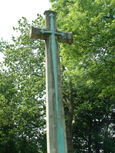
The sword on the west side of the cross is missing, either stolen or fallen off and never replaced. This Portland stone cross is badly weathered and it is almost impossible to make out the inscriptions.
johncoxon 8:34 AM - [Link] - Comments ()
...
UNARMED BRITISH POLICE ?
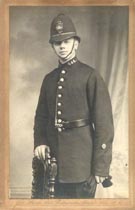
Although there are very rare cases of corruption, ( "bent" coppers), and some other aberations leading to negative publicity, I still feel very proud of the British Police, what they stand for, and the way they conduct themselves,so often with good humour and considerable restraint.
From the outside world looking in, many peoples' perception of the British police officer has changed little from the image of the affable London 'bobby' with that impractical but instantly recognisable domed helmet, and armed with just a wooden truncheon and whistle. This basic equipment does not seem that different from their New York counterpart of the 1880's, with the exception of the hand gun.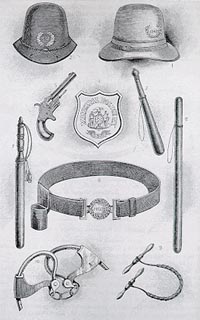
That stereotypical image was re-inforced by the Ealing studio's film classic "The Blue Lamp" (1949) and especially by the re-assuring "Dixon of Dock Green" television drama that was such popular, national, Saturday night BBC viewing during its run between 1955-1976.(It is still currently, at 429 episodes, the longest running British police T.V.drama and ran for 21 years.) It was superseded, by, at first, 'Z.cars', introduced to reflect the criminally seamier world we then actually lived in ( which had been more than a little romanticised in Dixon of Dock Green. The programme always began and ended outside the police station,early evening, under the famous blue lamp with actor Jack Warner's ( who starred in the original film the Blue Lamp) softly spoken prologue beginning with the friendly greeting "Evenin' all." 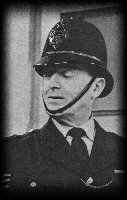
The story lines weren't major crimes, heavy social issue laden, or sensationalism. George Dixon was very much played as the steady, reliable father figure in the local community largely involved with small time criminals who were always apprehended. Each episode always ended with Dixon under that blue light again, summing up and adding a cosy homily before politely saluting to camera and wishing us all good night.
The originator of the first T.V. 'Copper' programme was Ted Willis ( copper was, and is still a slang term for a police officer. Copper can be either derogatory or even affectionate depending on who it is using the word and, I think originated from the use of large copper buttons on early police uniforms)
Willis, spent a few weeks in Paddington Police station researching and gathering anecdotes on which to base his story lines. That may in part explain why, in many ways, the stories seemed from an era of policing that had, sadly, already just passed and the series was really nostalgia and moving further and further away from the everyday reality the nearer it got to then end of its run.
Whilst police officers still wear the traditional helmet, from speaking to them, they tend to see it as impractical, uncomfortable and offering little protection and, yes, a proud icon of British policing, but best saved, perhaps these days for ceremonial occasions and very low risk policing areas.
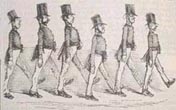
This Punch cartoon ridiculing London's first organised police force, the 'Peelers', (named after Tory, Sir Robert Peel, who introduced the parliamentary bill that led to their formation), is a picture link to an academic web site which gives an illustrated (contemporary engravings) account of law and order issues in London in the 19th century. It also has fascinating illustrated sections devoted to all other aspects of city life at that time and perhaps helps put modern trends into some kind of perspective, especially in view of the dramtic increase we have seen since then in our population.)
Because times have changed, crime has increased, and hostility towards the police and assaults against them have, sadly, become more and more common place. Reflecting this, British police today look very different in comparison with that somewhat romantic stereotype. But it is only really, very recently that the majority of officers have worn, as every day issue, protective body armour, either over or under their clothing ( effective against stabbing, but not, necessarily gun shot) and carrying the American style, carbon fibre,light weight, telescopic baton.
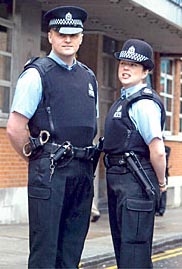
Officers I have spoken to welcome the baton as a major improvement to the old impractical wooden baton or 'truncheon' and one I know said that the satisfying crack the stick made when it was drawn was an effective deterrent alone.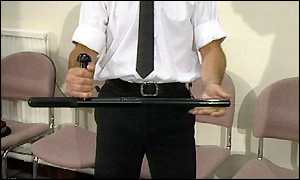
They also carry, as a matter of course, 'incapacitant' spray, radio and newly designed rigid handcuffs.
It still puzzles many foreigners why British Police continue to reject the idea of carrying a firearm for self-defence. On that important issue , a recent press release from the The Police Federation (May 2003) is revealing. It presents the results of opinion polls carried out amongst our police forces. It seems the majority of our police do not want to be routinely armed, feel that their current protective clothing and equipment is fairly adequate, but do want more trained police officers on the street. They also want more officers trained in the use of fire arms. In view of the fact that of a sample representing 57,000 police, 50eported that their lives had been placed in serious danger by a member of the public in the last two years and the rise in gun related crimes their shyness of guns seems laudale and courageous. 7ad been threatened with a gun in the last two years. 40ad been injured in assaults by members of the public.
94ad been issued with 'incapacitant' spray, 98ssued with a baton. 72ad been issued with overt body armour; 31ith covert body armour.Between 1998 and 2001, trained officers were issued with firearms 44,871 times, resulting in just 11 fatal shootings. Thus, as testament, they maintain, to police restraint, that represents 1 fatal shot for every 4,079 firearms operations, a remarkble record.
In January this year, Jan Berry, Chair of the Police Federation, welcoming the new proposal for a minimum 5 year sentence for the offence of carrying a fire arm amongst other reforms of the gun laws, said:-
"We do not want our country to go the same way as America, nor do we wish to see police officers routinely armed. But if gun crime continues its rapid rise we will have to think seriously about the best options to protect us all."
It may seem curious to people from other countries, whose police all always carry firearms, that our police do not seem to wish to be routinely armed, but it is clear that the modern, better protected police generally still want to uphold the traditional British principle of the 'unarmed Bobby', but equally, that is not set in stone.
In this regard, the Home Office and The Police Federation have their officers' safety uppermost in mind and sensibly retain the right keep their options open with regard to whether officers need to be regularly armed. The government, it seems, have not, however been particulalry generous in funding the increase in man-power that is often called for, even though they recognise that Law and Order is still a major national concern. Fear of being the victim of crime, we hear, is in excess of what is really likely to happen, statistically in most places , but equally, so many people want to see more police walking the 'beat' on the street ; reassuringly visible. That has a cost implication that as yet doesn't seem to have been adequately addressed.
Further Reading :- OFFICER.COM
International Law enforcement directory designed for law enforcement professionals with a host of links which include listings of all UK on-line police forces.
johncoxon 5:52 PM - [Link] - Comments ()
...
Our very ordinary Victorian terraced house is built of a mixture of locally fired red clay bricks, following the common practice, especially in cheaper dwellings, of the builder using the better,hard, pressed, smoothe-surfaced housebricks on the front of the dwelling and cheaper, rougher bricks on the sides and back. And yet, Salford and Manchester have many magnificent large buildings from the same era with exquisite and ornate brickwork from the same clay.
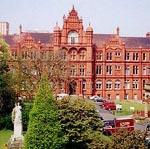
One of the finest examples in Salford of the Victorian brick art and the use of what is termed ceramic architecture is the Peel Building, part of what is now Salford University. The recently restored building was designed by H.Lord and built in 1896 to house the newly created Royal Salford Technical Institute, dedicated to providing education and training for the growing industrial economy in the north west and very largely funded by local industrialists. ( the institute was formed by a merger between the Pendleton Mechanics Institute(1850) and the Salford Working Men's College (1858)
Extensive use has been made of bright terracotta and the quality of the brick surfacing extends on every side, not on just the front,of what was even then, a lavish and very prestigious building for the city and symbol of the importance of key industrial trades like engineering to local economies.
There are two large terracotta relief panels on the front of the building depicting tradesman in their workshops ; one is of Industrial Chemists and the other Mechanical Engineers
Above the ornate main entrance is a wide terracotta relief panel depicting classical female figures, very probably representing the Five Muses.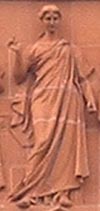
Either side of the main door are decorated paired Corinthian style pillars.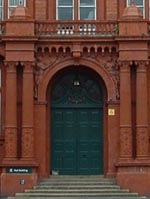
A small benign cherub is at the centre of each pillar decoration.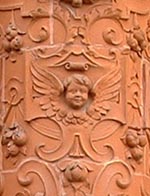
There is a grassed area in front of the building, all that remains of a larger park, where two white limestone statues face each other. The one, a young and then still smiling Queen Victoria and the other, her husband, the Prince Consort Albert whose untimely death plunged her into a life time of mourning it seems. The statue commemorates Victoria's visit to this very park in 1851; Albert unveiled the statue in 1857.
Even though I have visited the Local History Library and Art Gallery ( not ten yards from this spot) often, in the 25 years I have worked in Salford, I never really looked closely at the large clump of trees at the centre of the lawn. I was astonished at what I discovered recently almost hidden there by them. It was clearly built at the same time as the Peel Building, in the same material and style. 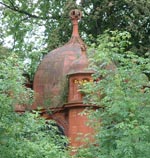
I think I know what this structure was built to do, knowing a little about the original site, but not enough to be completely sure. It certainly isn't for keeping doves or pigeons! I want to do a little more research before I commit myself to a definitive answer to the question what was the structure originally designed to do. Speculation, in the mean time, posted as a comment would be welcome.
Further Reading:-
Click on Victorian Terracotta to view a site with many photographs of fine examples of the Victorian use of terracotta in the structure of their brick built buildings.
johncoxon 2:40 AM - [Link] - Comments ()
...